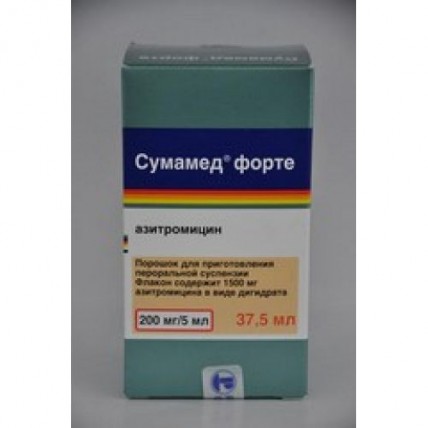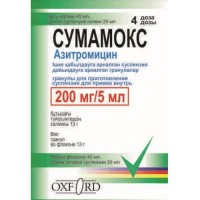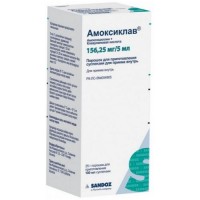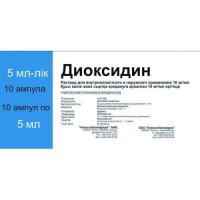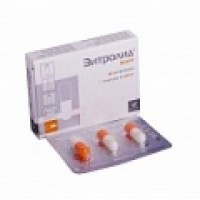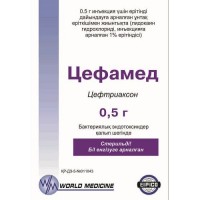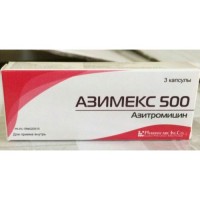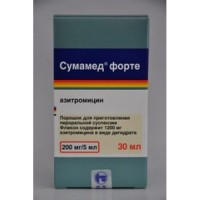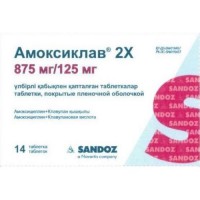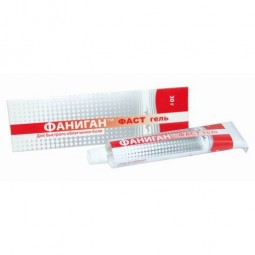Sumamed ® forte 200 mg / 5 ml 37.5 ml powder for oral suspension
- $35.50
The instruction
for medical use
of Sumamed® medicine forte
the Trade name
of Sumamed® forte
the International unlicensed
name Azithromycin Dosage Form Powder for preparation of suspension for intake, 200mg/5 ml
Structure
One bottle contains
active agent – azithromycin (in the form of dihydrate azithromycin) - 600 mg (for the volume of 15 ml), 1200 mg (for the volume of 30 ml), 1500 mg (for the volume of 37.5 ml).
excipients: sucrose, sodium phosphate anhydrous, hydroxy-propitsellyuloza, xanthane gum, silicon colloidal anhydrous, fragrance cherry, fragrance banana and fragrance vanilla.
The description
the Granulated powder from white till light yellow color with a characteristic smell of banana and cherry.
The prepared solution - uniform suspension of white or light yellow color with a characteristic smell of banana and cherry.
Pharmacotherapeutic group
Antibacterial drugs for system use. Macroleads, linkozamida and streptogramina. Macroleads. Azithromycin.
The ATX J01FA10 code
the Pharmacological
Pharmacokinetics Azithromycin properties is quickly soaked up at oral administration that is caused by its acidic environment resistance and lipophilicity. After single dose 37% of azithromycin are inside soaked up, and the peak of concentration in plasma (0.41µg/мл) is registered in 2-3 hours. The volume of distribution of Vd is about 31 l/kg. Azithromycin well gets into airways, bodies and fabrics of an urogenital path, a prostate, into skin and soft tissues, reaching from 1 to 9 µg/мл depending on a type of fabric. High concentration in fabrics (is 50 times higher, than concentration in plasma) and the long half-life period is caused by low linking of azithromycin with proteins of blood plasma and also its ability to get into eukaryotic cells and to concentrate in the environment with a low rn, surrounding lysosomes. The ability of azithromycin to collect in lysosomes is especially important for elimination of intracellular activators. Phagocytes deliver azithromycin to places of localization of an infection where it is released in the course of phagocytosis. But, despite high concentration in phagocytes, azithromycin does not affect their function. Therapeutic concentration remains 5-7 days after intake of the last dose. At intake of azithromycin perhaps tranzitorny increase in activity of liver enzymes. Removal of a half of a dose from blood plasma is reflected on reduction of a half of a dose in fabrics within 2-4 days. After administration of drug in the range from 8 till 24 o'clock elimination half-life makes 14-20 hours, and after administration of drug in the range from 24 till 72 o'clock – 41 hour that allows to accept Sumamed® forte 1 time a day. The main way of removal – with bile. About 50% are removed in not changed look, other 50% - in the form of 10 inactive metabolites. About 6% of the accepted dose are removed by kidneys.
The pharmacodynamics
Active agent of the drug Sumamed® forte - azithromycin is an antibiotic of a broad spectrum of activity, the first representative of new subgroup of makrolidny antibiotics – azaleads.
Possesses bacteriostatic action, but during creation in the center of inflammation of high concentrations causes bactericidal effect. Azithromycin suppresses synthesis of protein in sensitive microorganisms, showing activity concerning the majority of strains of gram-positive, gram-negative, anaerobic, intracellular and other microorganisms: Mycoplasma pneumoniae, Haemophilus ducreyi, Moraxella catarrhalis, Propionibacterium acnes, Gardnerella vaginalis, Actinomyces species, Bordetella pertussis, Borrelia burgdorferi, Mobiluncus species, Haemophilus influenzae, Streptococcus pyogenes, Haemophilus parainfluenzae, Streptococcus pneumoniae, Legionella pneumophila, Streptococcus agalactiae, Neisseria meningitides, Streptococcus viridans, Neisseria gonorrhoeae, Streptococcus group C, F, G, Helicobacter pylori, Peptococcus species, Campylobacter jejuni, Peptostreptococcus, Pasteurella multocida, Fusobacterium necrophorum, Pasteurella haemolytica, Clostridium perfringens, Brucella melitensis, Bacteroides bivius, Bordetella parapertussis, Chlamydia trachomatis, Vibrio cholerae, Chlamydia pneumoniae, Vibrio parahaemolyticus, Ureaplasma urealyticum, Plesiomonas shigelloides, Listeria monocytogenes, Staphylococcus epidermidis, Staphylococcus aureus * (*эритромицин – a sensitive strain), Escherichia coli, Bacteroides fragilis, Salmonella enteritidis, Bacteroides oralis, Salmonella typhi, Clostridium difficile, Shigella sonnei, Eubacterium lentum, Yersinia enterocolitica, Fusobacterium nucleatum, Acinetobacter calcoaceticus, Aeromonas hydrophilia.
Indications
- upper respiratory tract infections (bacterial pharyngitis/tosyllitas, sinusitis, average otitis)
- lower respiratory tract infections (bronchitis, community-acquired pneumonia, exacerbation of chronic bronchitis)
- infections of skin and soft tissues (the chronic migrating erythema – an initial stage of a disease of Lyme, an ugly face, impetigo, secondary pyodermatoses)
- the infections of a stomach and a duodenum caused by Helicobacter pylori
the Route of administration and doses
of Sumamed® forte in the form of oral suspension accept 1 time a day in 1 hour prior to or in 2 hours after a meal by means of a measured spoon or the dosing syringe.
Infections of upper and lower airways, skin and soft tissues (except for the chronic migrating erythema)
the Course dose makes 30 mg/kg
two schemes of treatment Are applied:
1) 10 mg/kg of body weight once a day within 3 days
2) 10 mg/kg of body weight in the first day and on 5 mg/kg of body weight from the 2nd to the 5th day. To children drug is appointed proceeding from weight:
The body weight
of Sumamed®forte powder for preparation of oral suspension of 200 mg / 5 ml
of 10-14
kg 2.5 ml (100 mg)
of 15-25
kg 5 ml (200 mg)
of 25-34
kg 7.5 ml (300 mg)
of 35-44
kg 10 ml (400 mg)
≥ 45
kg 12.5 ml (500 mg)
Are noted that azithromycin is effective at treatment of streptococcal pharyngitis at children in the form of a single dose of 10 mg/kg or 20 mg/kg for 3 days.
For prevention of the pharyngitis caused by Streptococcus pyogenes with possible rheumatic fever as the associated disease applies penicillin.
The chronic migrating erythema
the Course dose of drug makes 60 mg/kg: once in day on 20 mg/kg - in the 1st day and on 10 mg/kg – in the subsequent, from 2 to 5 days.
Diseases of a stomach and a 12-perstny gut, associated with Helicobacter pylori:
20 mg/kg of body weight once a day in combination with anti-secretory means and other medicines.
In case the dose of drug was passed, it needs to be accepted at once, and then to accept the subsequent doses at an interval of the 24th hour.
Renal failure.
Patients with insignificant dysfunction of kidneys (SKF of 10-80 ml/min.) have no need to change a dose. Patients with heavy renal failures (SKF & lt, 10 ml/min.) need to apply azithromycin with care.
Liver failure.
As azithromycin is metabolized in a liver and removed with bile, drug should not be used to patients with a serious illness of a liver. The researches directed to studying influence of azithromycin on function of a liver were not conducted.
Elderly patients
to Patients of advanced age appoint the same dose, as the adult. Among elderly patients proaritmogenny states are possible therefore drug is used with care because of risk of developing cardiac arrhythmia and bidirectional tachycardia.
A way of preparation of suspension
each bottle has to contain suspensions 5 ml more course dose.
For preparation of 15 ml of suspension it is necessary to add 9.5 ml of water (20 ml of suspension) to the bottle containing 600 mg of azithromycin.
For preparation of 30 ml of suspension it is necessary to add 16.5 ml of water (35 ml of suspension) to the bottle containing 1200 mg of azithromycin.
For preparation of 37.5 ml of suspension it is necessary to add 20 ml of water (42.5 ml of suspension) to the bottle containing 1500 mg of azithromycin.
Before reception the bottle contents are carefully shaken up before receiving uniform suspension. Directly after intake of suspension to the child allow to drink several drinks of liquid to wash away and swallow the remained amount of suspension in an oral cavity.
Side effects
Often:
- vomiting, diarrhea, an abdominal pain, nausea, discomfort in a stomach, paresthesia, disturbances of taste, a headache, an arthralgia, fatigue
Infrequently:
- nervousness, insomnia, drowsiness, a cardiopalmus, an asthma, nasal bleeding, a constipation, a meteorism, dyspepsia, gastritis, an abdominal distension, dryness in a mouth, an eructation, hypersecretion of sialadens, a small tortoiseshell, dermatitis, xeroderma, vaginal infections, fungal infections, a bacterial infection, a gastroenteritis, respiratory disorders, oral cavity candidiasis, a leukopenia, a neutropenia, an eosinophilia, a Quincke's disease, hypersensitivity, disorders of vision, a hearing disorder, an osteoarthritis, myalgia, a dorsodynia, a dysuria, renal pain, a metrorrhagia, defeat of testicles, an indisposition, fatigue, hypostasis, a stethalgia, fever, peripheral hypostases, increase in level aminotransferase aspartate, increase in level aminotransferase alanine, increase in bilirubin in blood, increase in urea in blood, increase in creatinine in blood, abnormal level of potassium in blood, increase in level of alkaline phosphatase in blood, increase in level of glucose, increase in level of thrombocytes, reduction of a hematocrit, increase in bicarbonate, abnormal level of sodium, a hypesthesia, sonitus, hepatitis, Stephens-Johnson's syndrome, an asthenia
Seldom:
- contagious excitation (agitation)
- abnormal hepatic function, cholestatic jaundice
- reactions of photosensitivity
Is unknown:
- pseudomembranous colitis, thrombocytopenia, hemolytic anemia anaphylactic reaction, aggression, alarm, nonsense, hallucinations, faints, spasms, psychomotor hyperactivity, an anosmia, an ageusia, a parosomiya, a myasthenia, a hearing disorder, bidirectional tachycardia and arrhythmia including ventricular tachycardia, lengthening of an interval of QT on the ECG, hypotension, pancreatitis, decolouration of language, a liver failure, lightning hepatitis, liver necrosis, a toksicheky epidermal necrolysis, a multiformny erythema, an arthralgia, an acute liver failure, interstitial nephrite
of the Contraindication
Hypersensitivity to azithromycin, erythromycin or makrolidny and ketolidny antibiotics, or other components of drug.
Medicinal interactions
Antacids: When studying influence of simultaneous use of antacids on pharmacokinetics of azithromycin did not note changes of bioavailability though the maximum concentration of azithromycin in blood plasma decreased by 25%. Patients should not accept azithromycin and antacids at the same time. Tsetirizin: At healthy volunteers, did not lead joint reception of a 5-day rate of azithromycin from tsetiriziny 20 mg in an equilibrium state to pharmacokinetic interaction and significant change in QT interval.
Didanozin (didezoksiinozin): Joint reception of 1200 mg/days of azithromycin of 400 mg/days of a didanozin at 6 HIV-positive patients, does not influence an equilibrium condition of pharmacokinetics of a didanozin in comparison with placebo.
Digoxin (P-gp substrates): Simultaneous use of makrolidny antibiotics, including azithromycin, with P-glycoprotein substrates, such as digoxin leads to increase in serumal levels of substrates of a P-glycoprotein. Therefore at simultaneous use of azithromycin and substrates of a P-glycoprotein, such as digoxin, it is necessary to remember a possibility of increase in concentration of substrates of a P-glycoprotein in serum.
Zidovudine: At single use of 1000 mg and repeated use of 1200 mg or 600 mg of azithromycin the insignificant influence on plasma pharmacokinetics or removal with urine of a zidovudine or its glyukuronidny metabolites is revealed. However intake of azithromycin increased concentration of a fosforilirovanny zidovudine (clinically active metabolite) in mononukleara of peripheral blood. There is uncertain a clinical importance of these indicators, but perhaps they can be useful to patients.
Azithromycin does not interact with the system of P450 cytochrome of a liver. He does not participate in pharmacokinetic medicinal interaction as erythromycin and other macroleads. Azithromycin does not induce or inactivates P450 cytochrome by means of a complex cytochrome metabolite.
Ergotamine derivatives: Because of a theoretical possibility of development of an ergotism, simultaneous use of azithromycin with derivatives of an ergot is not recommended. Pharmacokinetic researches were conducted with azithromycin and the following drugs with known R450-cytochrome mediated metabolizy.
Atorvastatin: Joint introduction of an atorvastatin (10 mg daily) and azithromycin (500 mg daily) did not change concentration of an atorvastatin in blood plasma (on the basis of the analysis of HMG CoA-reductases). Nevertheless, post-marketing cases of a rhabdomyolysis at the patients receiving azithromycin with statines are registered.
Carbamazepine: In a research of pharmacokinetic interaction of azithromycin on healthy volunteers, drug had no considerable impact on carbamazepine level in blood plasma or on its active metabolites.
Cimetidinum: Change of pharmacokinetics of azithromycin was not noted in the pharmacokinetic research studying action of the single dose of Cimetidinum accepted in 2 hours prior to azithromycin on azithromycin pharmacokinetics.
Coumarinic oral anticoagulants: In pharmacokinetic researches of interaction, azithromycin does not change anticoagulating effect of the single dose of 15 mg of warfarin entered to healthy volunteers. During the post-marketing period messages about strengthening of anti-coagulation after joint intake of azithromycin and oral coumarinic anticoagulants are received. Though relationship of cause and effect is not established, it is necessary to consider the frequency of monitoring of a prothrombin time, when prescribing azithromycin the patient receiving oral anticoagulants like coumarin.
Cyclosporine: In a pharmacokinetic research at healthy volunteers who within 3 days orally received 500 mg/day of azithromycin and then once orally of 10 mg/kg of cyclosporine, Cmax and AUC0-5 of cyclosporine were much raised. Therefore, it is necessary to show care before considering simultaneous administration of these drugs. If joint administration of these drugs is necessary, it is necessary to control levels of cyclosporine and as appropriate to correct a dose.
Efavirenz: Joint reception of a single dose of azithromycin of 600 mg and 400 mg of an efavirenz a day within 7 days does not lead to clinically significant pharmacokinetic interactions.
Flukonazol: Joint reception of a single dose of 1200 mg of azithromycin does not change pharmacokinetics of a single dose of 800 mg of a flukonazol. The general influence and elimination half-life of azithromycin did not change at joint introduction with flukonazoly, however, clinically insignificant decrease in Cmax (18%) of azithromycin was observed.
Indinavir: Joint reception of a single dose of 1200 mg of azithromycin did not make significant impact on pharmacokinetics of the indinavir entered in a dosage of 800 mg three times a day within 5 days.
Methylprednisolonum: In a research of pharmacokinetic interaction at healthy volunteers azithromycin did not show considerable influence on Methylprednisolonum pharmacokinetics.
Midazolam: At healthy volunteers, joint introduction with azithromycin of 500 mg/days within 3 days does not cause clinically significant changes in pharmacokinetics and a pharmacodynamics of a single dose of 15 mg of midazolam.
Nelfinavir: Joint administration of azithromycin (1200 mg) and nelfinaviry in an equilibrium state (750 mg three times a day) led to increase in concentration of azithromycin. Clinically significant side effects were not observed and dose adjustment is not required.
Rifabutin: Simultaneous use of azithromycin and a rifabutin did not affect concentration of these drugs in blood plasma.
The neutropenia was revealed at simultaneous use of azithromycin and a rifabutin. Though the neutropenia was connected with use of a rifabutin, the causal relationship was not established with a concomitant use of azithromycin.
Sildenafil: At normal healthy male volunteers, the evidence of influence of azithromycin (500 mg daily within 3 days) on AUC and Cmax of a sildenafil or its main circulating metabolite is not obtained.
Terfenadin: In pharmacokinetic researches it was not reported about interaction between azithromycin and terfenadiny. In certain cases it is not possible to exclude interaction probability completely. Nevertheless, the specific evidence that such interaction took place was not obtained.
Theophylline: The evidence of clinically significant pharmacokinetic interaction between azithromycin and theophylline at their simultaneous use by healthy volunteers is not obtained.
To triazoles: 14 healthy volunteers, joint administration of azithromycin have 500 mg for 1 day and 250 mg for 2 day from 0.125 mg of a triazolam for the 2nd day had no significant effect on any of pharmacokinetic variables for a triazolam in comparison with joint introduction of a triazolam and placebo.
Trimethoprimum / sulfamethoxazole: Joint administration of DS Trimethoprimum / sulfamethoxazole (160 mg / 800 mg) within 7 days with azithromycin of 1200 mg for the 7th day had no significant effect on the maximum concentration, the general influence or removal of Trimethoprimum or sulfamethoxazole. Concentration of azithromycin in serum resembled that, observed in other researches.
The special
instructions Drug Use Duration should not exceed the terms specified in the instruction. As well as in a case with other macroleads, it was reported about rare serious allergic reactions, including a Quincke's edema and anaphylaxis. Some of these reactions to azithromycin lead to development of recurrent symptoms and demand longer period of observation and treatment. The liver is the main body for azithromycin removal therefore patients should appoint azithromycin with care with the profound disease of a liver. In case of signs and symptoms of dysfunction of a liver, such as quickly developing asthenia connected with jaundice, dark urine, tendency to bleedings or hepatic encephalopathy to immediately carry out functional trials livers / analyses. At development of dysfunction of a liver to stop intake of azithromycin. At the patients receiving ergot derivatives, emergence of an ergotism is provoked by a concomitant use of some makrolidny antibiotics. There are no data on a possibility of interaction between an ergot and azithromycin. Nevertheless, because of a theoretical possibility of development of an ergotism, azithromycin and derivatives of an ergot are accepted separately. As well as at reception of any antibiotics, the observation of signs of superinfection caused by resistant microorganisms including mushrooms is recommended. The diarrhea caused by Clostridium difficile (CDAD) was reported in all cases of use of antibacterial agents, including azithromycin, and can vary on severity from slight diarrhea to heavy colitis. Treatment by antibacterial agents changes normal flora of intestines that conducts to the overgrowth of C. difficile. At patients with a heavy renal failure (SKF & lt, 10 ml/min.) observed 33% increase in system influence of azithromycin. It is necessary to be careful at use of Sumamed® forte at patients with existence of proaritmogenny factors (especially at elderly patients), including with the congenital or acquired lengthening of an interval of QT, at the patients taking the antiarrhytmic drugs of the classes IA (quinidine, procaineamide), III (dofetilid, Amiodaronum and sotalol), tsizapridy, terfenadiny, antipsychotic drugs (Pimozidum), antidepressants (tsitalopra), ftorkhinolinam (moxifloxacin and levofloxacin), with disturbances of a water and electrolytic baoans, especially in case of a hypopotassemia or a hypomagnesiemia, clinically significant bradycardia, arrhythmia of heart or heavy heart failure. Drug Sumamed® use forte can provoke development of a myasthenic syndrome or cause aggravation of a myasthenia.
Sucrose Drug contains sucrose. Patients with rare hereditary diseases of intolerance of fructose, a sprue of glucose and a galactose or sakharazo-izomaltazny insufficiency should not take this drug.
Pregnancy
Use of drug at pregnancy is possible when the expected advantage exceeds potential risk for a fruit.
The feature of influence of medicine on ability to run the vehicle or potentially dangerous
Sumamed® mechanisms forte does not influence speed of response at control of vehicles and work with other mechanisms.
Overdose
of Data on overdose there is no Sumamed® forte. The overdose by makrolidny antibiotics is shown by nausea, vomiting and diarrhea. In case of overdose it is necessary to accept activated carbon and to carry out the symptomatic therapy directed to maintenance of vital signs of an organism.
The form of release and packing
On 16.7 g, 29.30 g or 35.6 g of powder of drug place in bottles from polyethylene of high density, with the twisting cover with protection against opening by children.
On 1 bottle with a measured spoon and/or the syringe for dosing together with the instruction for use in the state and Russian languages place in a pack from cardboard.
To Store storage conditions at a temperature not above 25 °C
to Store out of children's reach!
Period of storage
2 years.
The prepared suspension: 15 ml - 5 days, 30 ml and 37.5 ml – 10 days.
Not to apply after an expiration date.
Prescription status
According to the prescription
the Producer Pliva Hrvatsk of of the lake
of the island of Prilaz of a barun of Filippovich 25,
10000 Zagreb, Croatia
the Name and the country of the owner of the registration certificate
Pliva Hrvatsk of of the lake of the lake, Croatia
the Address of the organization accepting in the territory of the Republic of Kazakhstan claims from consumers on quality of products (goods):
Ratiofarm Kazakhstan LLP
050000, Republic of Kazakhstan Almaty, Al-Farabi Avenue 19,
Nurla Tau's Business center 1B of office
603,604 Phone number, fax (727) 311-09-15, 311-07-34
E-mail:
To Develop Safety.Kazakhstan@tevapharm.com
for medical use
of Sumamed® medicine forte
the Trade name
of Sumamed® forte
the International unlicensed
name Azithromycin Dosage Form Powder for preparation of suspension for intake, 200mg/5 ml
Structure
One bottle contains
active agent – azithromycin (in the form of dihydrate azithromycin) - 600 mg (for the volume of 15 ml), 1200 mg (for the volume of 30 ml), 1500 mg (for the volume of 37.5 ml).
excipients: sucrose, sodium phosphate anhydrous, hydroxy-propitsellyuloza, xanthane gum, silicon colloidal anhydrous, fragrance cherry, fragrance banana and fragrance vanilla.
The description
the Granulated powder from white till light yellow color with a characteristic smell of banana and cherry.
The prepared solution - uniform suspension of white or light yellow color with a characteristic smell of banana and cherry.
Pharmacotherapeutic group
Antibacterial drugs for system use. Macroleads, linkozamida and streptogramina. Macroleads. Azithromycin.
The ATX J01FA10 code
the Pharmacological
Pharmacokinetics Azithromycin properties is quickly soaked up at oral administration that is caused by its acidic environment resistance and lipophilicity. After single dose 37% of azithromycin are inside soaked up, and the peak of concentration in plasma (0.41µg/мл) is registered in 2-3 hours. The volume of distribution of Vd is about 31 l/kg. Azithromycin well gets into airways, bodies and fabrics of an urogenital path, a prostate, into skin and soft tissues, reaching from 1 to 9 µg/мл depending on a type of fabric. High concentration in fabrics (is 50 times higher, than concentration in plasma) and the long half-life period is caused by low linking of azithromycin with proteins of blood plasma and also its ability to get into eukaryotic cells and to concentrate in the environment with a low rn, surrounding lysosomes. The ability of azithromycin to collect in lysosomes is especially important for elimination of intracellular activators. Phagocytes deliver azithromycin to places of localization of an infection where it is released in the course of phagocytosis. But, despite high concentration in phagocytes, azithromycin does not affect their function. Therapeutic concentration remains 5-7 days after intake of the last dose. At intake of azithromycin perhaps tranzitorny increase in activity of liver enzymes. Removal of a half of a dose from blood plasma is reflected on reduction of a half of a dose in fabrics within 2-4 days. After administration of drug in the range from 8 till 24 o'clock elimination half-life makes 14-20 hours, and after administration of drug in the range from 24 till 72 o'clock – 41 hour that allows to accept Sumamed® forte 1 time a day. The main way of removal – with bile. About 50% are removed in not changed look, other 50% - in the form of 10 inactive metabolites. About 6% of the accepted dose are removed by kidneys.
The pharmacodynamics
Active agent of the drug Sumamed® forte - azithromycin is an antibiotic of a broad spectrum of activity, the first representative of new subgroup of makrolidny antibiotics – azaleads.
Possesses bacteriostatic action, but during creation in the center of inflammation of high concentrations causes bactericidal effect. Azithromycin suppresses synthesis of protein in sensitive microorganisms, showing activity concerning the majority of strains of gram-positive, gram-negative, anaerobic, intracellular and other microorganisms: Mycoplasma pneumoniae, Haemophilus ducreyi, Moraxella catarrhalis, Propionibacterium acnes, Gardnerella vaginalis, Actinomyces species, Bordetella pertussis, Borrelia burgdorferi, Mobiluncus species, Haemophilus influenzae, Streptococcus pyogenes, Haemophilus parainfluenzae, Streptococcus pneumoniae, Legionella pneumophila, Streptococcus agalactiae, Neisseria meningitides, Streptococcus viridans, Neisseria gonorrhoeae, Streptococcus group C, F, G, Helicobacter pylori, Peptococcus species, Campylobacter jejuni, Peptostreptococcus, Pasteurella multocida, Fusobacterium necrophorum, Pasteurella haemolytica, Clostridium perfringens, Brucella melitensis, Bacteroides bivius, Bordetella parapertussis, Chlamydia trachomatis, Vibrio cholerae, Chlamydia pneumoniae, Vibrio parahaemolyticus, Ureaplasma urealyticum, Plesiomonas shigelloides, Listeria monocytogenes, Staphylococcus epidermidis, Staphylococcus aureus * (*эритромицин – a sensitive strain), Escherichia coli, Bacteroides fragilis, Salmonella enteritidis, Bacteroides oralis, Salmonella typhi, Clostridium difficile, Shigella sonnei, Eubacterium lentum, Yersinia enterocolitica, Fusobacterium nucleatum, Acinetobacter calcoaceticus, Aeromonas hydrophilia.
Indications
- upper respiratory tract infections (bacterial pharyngitis/tosyllitas, sinusitis, average otitis)
- lower respiratory tract infections (bronchitis, community-acquired pneumonia, exacerbation of chronic bronchitis)
- infections of skin and soft tissues (the chronic migrating erythema – an initial stage of a disease of Lyme, an ugly face, impetigo, secondary pyodermatoses)
- the infections of a stomach and a duodenum caused by Helicobacter pylori
the Route of administration and doses
of Sumamed® forte in the form of oral suspension accept 1 time a day in 1 hour prior to or in 2 hours after a meal by means of a measured spoon or the dosing syringe.
Infections of upper and lower airways, skin and soft tissues (except for the chronic migrating erythema)
the Course dose makes 30 mg/kg
two schemes of treatment Are applied:
1) 10 mg/kg of body weight once a day within 3 days
2) 10 mg/kg of body weight in the first day and on 5 mg/kg of body weight from the 2nd to the 5th day. To children drug is appointed proceeding from weight:
The body weight
of Sumamed®forte powder for preparation of oral suspension of 200 mg / 5 ml
of 10-14
kg 2.5 ml (100 mg)
of 15-25
kg 5 ml (200 mg)
of 25-34
kg 7.5 ml (300 mg)
of 35-44
kg 10 ml (400 mg)
≥ 45
kg 12.5 ml (500 mg)
Are noted that azithromycin is effective at treatment of streptococcal pharyngitis at children in the form of a single dose of 10 mg/kg or 20 mg/kg for 3 days.
For prevention of the pharyngitis caused by Streptococcus pyogenes with possible rheumatic fever as the associated disease applies penicillin.
The chronic migrating erythema
the Course dose of drug makes 60 mg/kg: once in day on 20 mg/kg - in the 1st day and on 10 mg/kg – in the subsequent, from 2 to 5 days.
Diseases of a stomach and a 12-perstny gut, associated with Helicobacter pylori:
20 mg/kg of body weight once a day in combination with anti-secretory means and other medicines.
In case the dose of drug was passed, it needs to be accepted at once, and then to accept the subsequent doses at an interval of the 24th hour.
Renal failure.
Patients with insignificant dysfunction of kidneys (SKF of 10-80 ml/min.) have no need to change a dose. Patients with heavy renal failures (SKF & lt, 10 ml/min.) need to apply azithromycin with care.
Liver failure.
As azithromycin is metabolized in a liver and removed with bile, drug should not be used to patients with a serious illness of a liver. The researches directed to studying influence of azithromycin on function of a liver were not conducted.
Elderly patients
to Patients of advanced age appoint the same dose, as the adult. Among elderly patients proaritmogenny states are possible therefore drug is used with care because of risk of developing cardiac arrhythmia and bidirectional tachycardia.
A way of preparation of suspension
each bottle has to contain suspensions 5 ml more course dose.
For preparation of 15 ml of suspension it is necessary to add 9.5 ml of water (20 ml of suspension) to the bottle containing 600 mg of azithromycin.
For preparation of 30 ml of suspension it is necessary to add 16.5 ml of water (35 ml of suspension) to the bottle containing 1200 mg of azithromycin.
For preparation of 37.5 ml of suspension it is necessary to add 20 ml of water (42.5 ml of suspension) to the bottle containing 1500 mg of azithromycin.
Before reception the bottle contents are carefully shaken up before receiving uniform suspension. Directly after intake of suspension to the child allow to drink several drinks of liquid to wash away and swallow the remained amount of suspension in an oral cavity.
Side effects
Often:
- vomiting, diarrhea, an abdominal pain, nausea, discomfort in a stomach, paresthesia, disturbances of taste, a headache, an arthralgia, fatigue
Infrequently:
- nervousness, insomnia, drowsiness, a cardiopalmus, an asthma, nasal bleeding, a constipation, a meteorism, dyspepsia, gastritis, an abdominal distension, dryness in a mouth, an eructation, hypersecretion of sialadens, a small tortoiseshell, dermatitis, xeroderma, vaginal infections, fungal infections, a bacterial infection, a gastroenteritis, respiratory disorders, oral cavity candidiasis, a leukopenia, a neutropenia, an eosinophilia, a Quincke's disease, hypersensitivity, disorders of vision, a hearing disorder, an osteoarthritis, myalgia, a dorsodynia, a dysuria, renal pain, a metrorrhagia, defeat of testicles, an indisposition, fatigue, hypostasis, a stethalgia, fever, peripheral hypostases, increase in level aminotransferase aspartate, increase in level aminotransferase alanine, increase in bilirubin in blood, increase in urea in blood, increase in creatinine in blood, abnormal level of potassium in blood, increase in level of alkaline phosphatase in blood, increase in level of glucose, increase in level of thrombocytes, reduction of a hematocrit, increase in bicarbonate, abnormal level of sodium, a hypesthesia, sonitus, hepatitis, Stephens-Johnson's syndrome, an asthenia
Seldom:
- contagious excitation (agitation)
- abnormal hepatic function, cholestatic jaundice
- reactions of photosensitivity
Is unknown:
- pseudomembranous colitis, thrombocytopenia, hemolytic anemia anaphylactic reaction, aggression, alarm, nonsense, hallucinations, faints, spasms, psychomotor hyperactivity, an anosmia, an ageusia, a parosomiya, a myasthenia, a hearing disorder, bidirectional tachycardia and arrhythmia including ventricular tachycardia, lengthening of an interval of QT on the ECG, hypotension, pancreatitis, decolouration of language, a liver failure, lightning hepatitis, liver necrosis, a toksicheky epidermal necrolysis, a multiformny erythema, an arthralgia, an acute liver failure, interstitial nephrite
of the Contraindication
Hypersensitivity to azithromycin, erythromycin or makrolidny and ketolidny antibiotics, or other components of drug.
Medicinal interactions
Antacids: When studying influence of simultaneous use of antacids on pharmacokinetics of azithromycin did not note changes of bioavailability though the maximum concentration of azithromycin in blood plasma decreased by 25%. Patients should not accept azithromycin and antacids at the same time. Tsetirizin: At healthy volunteers, did not lead joint reception of a 5-day rate of azithromycin from tsetiriziny 20 mg in an equilibrium state to pharmacokinetic interaction and significant change in QT interval.
Didanozin (didezoksiinozin): Joint reception of 1200 mg/days of azithromycin of 400 mg/days of a didanozin at 6 HIV-positive patients, does not influence an equilibrium condition of pharmacokinetics of a didanozin in comparison with placebo.
Digoxin (P-gp substrates): Simultaneous use of makrolidny antibiotics, including azithromycin, with P-glycoprotein substrates, such as digoxin leads to increase in serumal levels of substrates of a P-glycoprotein. Therefore at simultaneous use of azithromycin and substrates of a P-glycoprotein, such as digoxin, it is necessary to remember a possibility of increase in concentration of substrates of a P-glycoprotein in serum.
Zidovudine: At single use of 1000 mg and repeated use of 1200 mg or 600 mg of azithromycin the insignificant influence on plasma pharmacokinetics or removal with urine of a zidovudine or its glyukuronidny metabolites is revealed. However intake of azithromycin increased concentration of a fosforilirovanny zidovudine (clinically active metabolite) in mononukleara of peripheral blood. There is uncertain a clinical importance of these indicators, but perhaps they can be useful to patients.
Azithromycin does not interact with the system of P450 cytochrome of a liver. He does not participate in pharmacokinetic medicinal interaction as erythromycin and other macroleads. Azithromycin does not induce or inactivates P450 cytochrome by means of a complex cytochrome metabolite.
Ergotamine derivatives: Because of a theoretical possibility of development of an ergotism, simultaneous use of azithromycin with derivatives of an ergot is not recommended. Pharmacokinetic researches were conducted with azithromycin and the following drugs with known R450-cytochrome mediated metabolizy.
Atorvastatin: Joint introduction of an atorvastatin (10 mg daily) and azithromycin (500 mg daily) did not change concentration of an atorvastatin in blood plasma (on the basis of the analysis of HMG CoA-reductases). Nevertheless, post-marketing cases of a rhabdomyolysis at the patients receiving azithromycin with statines are registered.
Carbamazepine: In a research of pharmacokinetic interaction of azithromycin on healthy volunteers, drug had no considerable impact on carbamazepine level in blood plasma or on its active metabolites.
Cimetidinum: Change of pharmacokinetics of azithromycin was not noted in the pharmacokinetic research studying action of the single dose of Cimetidinum accepted in 2 hours prior to azithromycin on azithromycin pharmacokinetics.
Coumarinic oral anticoagulants: In pharmacokinetic researches of interaction, azithromycin does not change anticoagulating effect of the single dose of 15 mg of warfarin entered to healthy volunteers. During the post-marketing period messages about strengthening of anti-coagulation after joint intake of azithromycin and oral coumarinic anticoagulants are received. Though relationship of cause and effect is not established, it is necessary to consider the frequency of monitoring of a prothrombin time, when prescribing azithromycin the patient receiving oral anticoagulants like coumarin.
Cyclosporine: In a pharmacokinetic research at healthy volunteers who within 3 days orally received 500 mg/day of azithromycin and then once orally of 10 mg/kg of cyclosporine, Cmax and AUC0-5 of cyclosporine were much raised. Therefore, it is necessary to show care before considering simultaneous administration of these drugs. If joint administration of these drugs is necessary, it is necessary to control levels of cyclosporine and as appropriate to correct a dose.
Efavirenz: Joint reception of a single dose of azithromycin of 600 mg and 400 mg of an efavirenz a day within 7 days does not lead to clinically significant pharmacokinetic interactions.
Flukonazol: Joint reception of a single dose of 1200 mg of azithromycin does not change pharmacokinetics of a single dose of 800 mg of a flukonazol. The general influence and elimination half-life of azithromycin did not change at joint introduction with flukonazoly, however, clinically insignificant decrease in Cmax (18%) of azithromycin was observed.
Indinavir: Joint reception of a single dose of 1200 mg of azithromycin did not make significant impact on pharmacokinetics of the indinavir entered in a dosage of 800 mg three times a day within 5 days.
Methylprednisolonum: In a research of pharmacokinetic interaction at healthy volunteers azithromycin did not show considerable influence on Methylprednisolonum pharmacokinetics.
Midazolam: At healthy volunteers, joint introduction with azithromycin of 500 mg/days within 3 days does not cause clinically significant changes in pharmacokinetics and a pharmacodynamics of a single dose of 15 mg of midazolam.
Nelfinavir: Joint administration of azithromycin (1200 mg) and nelfinaviry in an equilibrium state (750 mg three times a day) led to increase in concentration of azithromycin. Clinically significant side effects were not observed and dose adjustment is not required.
Rifabutin: Simultaneous use of azithromycin and a rifabutin did not affect concentration of these drugs in blood plasma.
The neutropenia was revealed at simultaneous use of azithromycin and a rifabutin. Though the neutropenia was connected with use of a rifabutin, the causal relationship was not established with a concomitant use of azithromycin.
Sildenafil: At normal healthy male volunteers, the evidence of influence of azithromycin (500 mg daily within 3 days) on AUC and Cmax of a sildenafil or its main circulating metabolite is not obtained.
Terfenadin: In pharmacokinetic researches it was not reported about interaction between azithromycin and terfenadiny. In certain cases it is not possible to exclude interaction probability completely. Nevertheless, the specific evidence that such interaction took place was not obtained.
Theophylline: The evidence of clinically significant pharmacokinetic interaction between azithromycin and theophylline at their simultaneous use by healthy volunteers is not obtained.
To triazoles: 14 healthy volunteers, joint administration of azithromycin have 500 mg for 1 day and 250 mg for 2 day from 0.125 mg of a triazolam for the 2nd day had no significant effect on any of pharmacokinetic variables for a triazolam in comparison with joint introduction of a triazolam and placebo.
Trimethoprimum / sulfamethoxazole: Joint administration of DS Trimethoprimum / sulfamethoxazole (160 mg / 800 mg) within 7 days with azithromycin of 1200 mg for the 7th day had no significant effect on the maximum concentration, the general influence or removal of Trimethoprimum or sulfamethoxazole. Concentration of azithromycin in serum resembled that, observed in other researches.
The special
instructions Drug Use Duration should not exceed the terms specified in the instruction. As well as in a case with other macroleads, it was reported about rare serious allergic reactions, including a Quincke's edema and anaphylaxis. Some of these reactions to azithromycin lead to development of recurrent symptoms and demand longer period of observation and treatment. The liver is the main body for azithromycin removal therefore patients should appoint azithromycin with care with the profound disease of a liver. In case of signs and symptoms of dysfunction of a liver, such as quickly developing asthenia connected with jaundice, dark urine, tendency to bleedings or hepatic encephalopathy to immediately carry out functional trials livers / analyses. At development of dysfunction of a liver to stop intake of azithromycin. At the patients receiving ergot derivatives, emergence of an ergotism is provoked by a concomitant use of some makrolidny antibiotics. There are no data on a possibility of interaction between an ergot and azithromycin. Nevertheless, because of a theoretical possibility of development of an ergotism, azithromycin and derivatives of an ergot are accepted separately. As well as at reception of any antibiotics, the observation of signs of superinfection caused by resistant microorganisms including mushrooms is recommended. The diarrhea caused by Clostridium difficile (CDAD) was reported in all cases of use of antibacterial agents, including azithromycin, and can vary on severity from slight diarrhea to heavy colitis. Treatment by antibacterial agents changes normal flora of intestines that conducts to the overgrowth of C. difficile. At patients with a heavy renal failure (SKF & lt, 10 ml/min.) observed 33% increase in system influence of azithromycin. It is necessary to be careful at use of Sumamed® forte at patients with existence of proaritmogenny factors (especially at elderly patients), including with the congenital or acquired lengthening of an interval of QT, at the patients taking the antiarrhytmic drugs of the classes IA (quinidine, procaineamide), III (dofetilid, Amiodaronum and sotalol), tsizapridy, terfenadiny, antipsychotic drugs (Pimozidum), antidepressants (tsitalopra), ftorkhinolinam (moxifloxacin and levofloxacin), with disturbances of a water and electrolytic baoans, especially in case of a hypopotassemia or a hypomagnesiemia, clinically significant bradycardia, arrhythmia of heart or heavy heart failure. Drug Sumamed® use forte can provoke development of a myasthenic syndrome or cause aggravation of a myasthenia.
Sucrose Drug contains sucrose. Patients with rare hereditary diseases of intolerance of fructose, a sprue of glucose and a galactose or sakharazo-izomaltazny insufficiency should not take this drug.
Pregnancy
Use of drug at pregnancy is possible when the expected advantage exceeds potential risk for a fruit.
The feature of influence of medicine on ability to run the vehicle or potentially dangerous
Sumamed® mechanisms forte does not influence speed of response at control of vehicles and work with other mechanisms.
Overdose
of Data on overdose there is no Sumamed® forte. The overdose by makrolidny antibiotics is shown by nausea, vomiting and diarrhea. In case of overdose it is necessary to accept activated carbon and to carry out the symptomatic therapy directed to maintenance of vital signs of an organism.
The form of release and packing
On 16.7 g, 29.30 g or 35.6 g of powder of drug place in bottles from polyethylene of high density, with the twisting cover with protection against opening by children.
On 1 bottle with a measured spoon and/or the syringe for dosing together with the instruction for use in the state and Russian languages place in a pack from cardboard.
To Store storage conditions at a temperature not above 25 °C
to Store out of children's reach!
Period of storage
2 years.
The prepared suspension: 15 ml - 5 days, 30 ml and 37.5 ml – 10 days.
Not to apply after an expiration date.
Prescription status
According to the prescription
the Producer Pliva Hrvatsk of of the lake
of the island of Prilaz of a barun of Filippovich 25,
10000 Zagreb, Croatia
the Name and the country of the owner of the registration certificate
Pliva Hrvatsk of of the lake of the lake, Croatia
the Address of the organization accepting in the territory of the Republic of Kazakhstan claims from consumers on quality of products (goods):
Ratiofarm Kazakhstan LLP
050000, Republic of Kazakhstan Almaty, Al-Farabi Avenue 19,
Nurla Tau's Business center 1B of office
603,604 Phone number, fax (727) 311-09-15, 311-07-34
E-mail:
To Develop Safety.Kazakhstan@tevapharm.com
